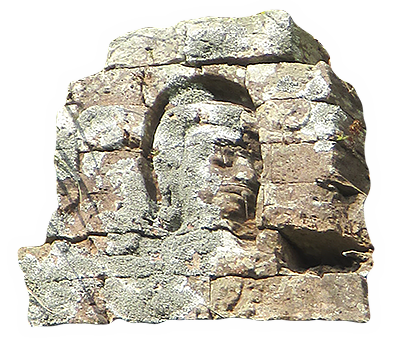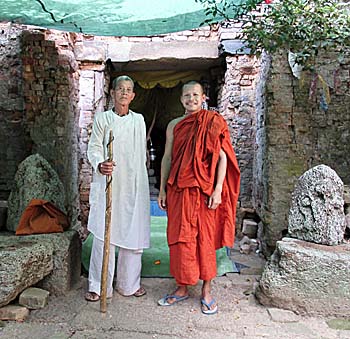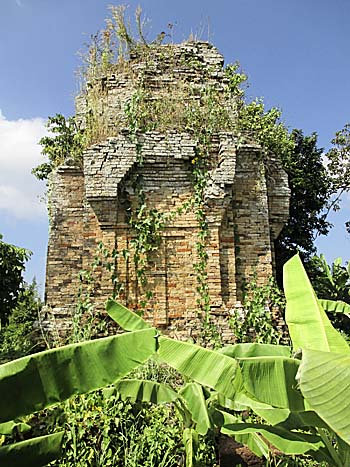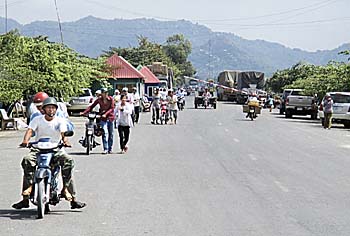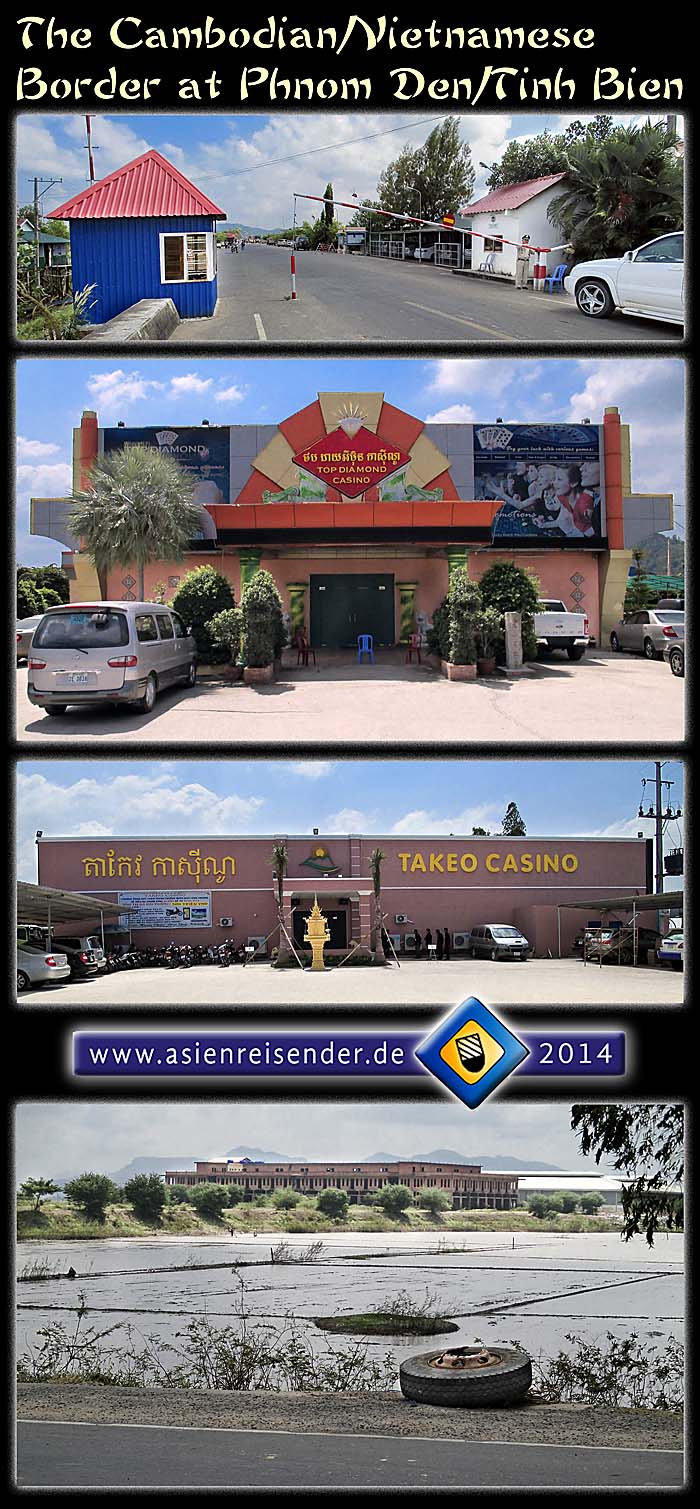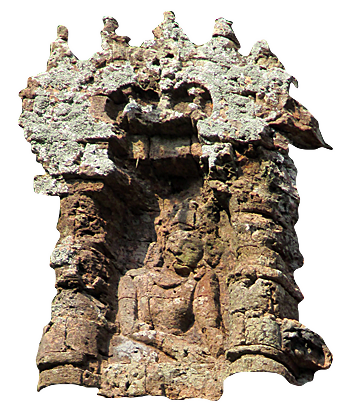1.
Phnom Bayang /
Phnom Bayong Monuments
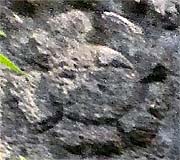
Flower ornamentic at Phnom Bayang temple. One of only three pieces I could identify. Image by Asienreisender, 2014
Bayang Temple on top of Phnom Bayang (Bayang Mountain) is said has been a victory monument of the water Chenla empire over the empire of Funan. This event might have triggered the move of the Sailendra Dynasty from Funan to Sumatra (Srivijaya empire) and later to central Java (Borobodur). Phnom Bayang was built in the years between 615-635 CE, when Funan was in it's late, ending phase. It consists of a main temple building on the very peak of Phnom Bayang and four side temples who are spread over the surrounding hill landscape.
Phnom Bayang
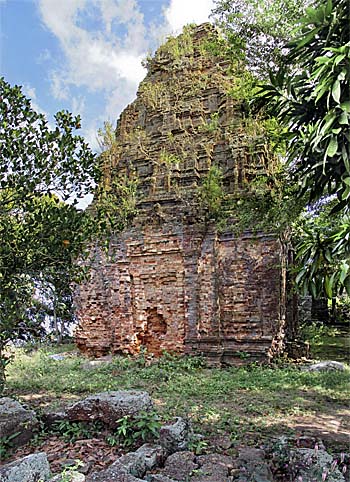
Phnom Bayang monument, seen from the backside.
Image by Asienreisender, 11/2014
The four outer or side temples are named Preah Kor temple, north Kanang temple, east Kanang temple and Kampoul Kanang temple.
In the old times there was probably a decent approach, a small road up to the peak. All the debris around speaks for that there was more construction, paved walkways, more steps, yards and probably encircling walls for the five monuments.
Phnom Bayang Temple was built in the reign of king Pavavarman II. It's far not that spectacular than the grand sights around Siem Reap, but the architecture is clearly related. It seems to me also, that there is a similarity to the medieval hindu monuments of central Java, namely Candi Bima (Dieng Plateau) and Prambanan.
Phnom Bayang is centuries older than the other mentioned monuments, and much, much smaller in size. It's built mostly with bricks; the stairways are built in laterite, as parts of the outer remains of what ever it was. Phnom Bayang temple has a size of 13m length, 9m width and a height of 12m. The building now appears in a pretty poor shape. The roof has collapsed, and the outer walls lost all of their former shape. However, considered it's age and the fact that there certainly happened little, if any, conservation work on it, it's still in a remarkable good shape. A closer look at it's outer walls reveal the remains of parts of former ornamentics. There is a head and a whole human to see, another spot shows a blooming flower as bedecking these old temple buildings so often. At the lower part of the towerlike main monument there are the remains of larger frescos with formerly sophisticated arrangements to see; one can only guess what it showed in the old days. Nevertheless, after all what I saw I would consider the buildings and the reliefs of high artistic and craftmanship quality - particularly the main temple.
Inside the main monument is the unavoidable shrine with many idols of the hindu and buddhist world placed. The sharp smell of bat's excrements gives a hint to some of the temples's inhabitants.
Around the temple tower are bushes and trees growing. Supposedly the jungle was cleared in the Chenla time. Where the sight is free, the peak grants a majectic view over this part of the Mekong River Delta to the east and to the forested hills respectively mountains to the western side.
A Journey up to Phnom Bayang
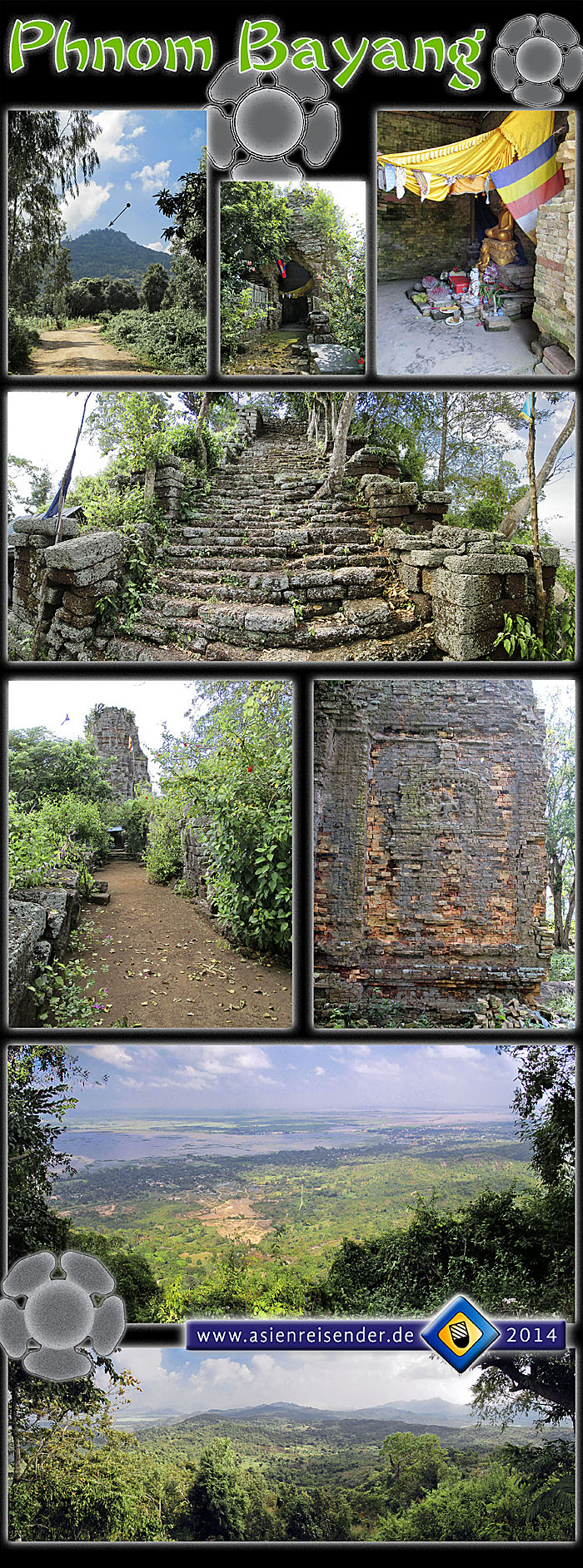
A short trip up to Phnom Bayang, depicted in eight photos.
The first image shows Phnom Bayang itself; 'Phnom' is Khmer for 'mountain', so, it's not actually the temple's name, but the mountains name. The mountain and it's peak is already to see when leaving the asphalt road and entering the sand road which leads up to the monuments.
After a long walk up a serpentine path one sees already right hand one of the four side temples. Next path turn right to visit it. The next two pictures show the monument's gate and how it looks inside. That's a typical temple arrangement as it is displayed in countless buddhist temples in Cambodia, Laos and particularly Thailand.
The broad photo below shows the second, much bigger part of the laterite stairway to the main monument on the peak of Phnom Bayang.
Once reached the top end of the stairway, one is facing the alley shown in the photo below left. The peak is broad and now overgrown with jungle. It's highly probable that in the time of the Chenla empire, when Phnom Bayang was an active sacred place, the whole of the peak was used by any arrangements. An amount of debris around shows that there was much more construction in the very past. Thats a similar observation at the side temple one passes on the way up. There are, by the way, alltogether four additional side temples spread over the mountains around the main monument.
Having approached the temple building and turning contra clockwise around, one sees the large fresco shown in the next photo. Unfortunately there is practically nothing recognizable anymore, except certainly for archeologists with a good deal of experience and professionality. On the opposite side there are three frescos still recognizable. That's the face at the top right of this page, the body in an arch seen at the top left of the page and the bloom shown on the top of the page left to the page navigation.
The peak offers stunning views over the Mekong Delta in the border region between Cambodia and Vietnam. The other side to the south is covered with mountains. It's a smaller mountain chain which runs half-way parallel to the national road 2 towards Vietnam.
The forest here is apparently secondary jungle. So close to the Vietnamese border, the international logging mafia has long since taken all the valuable trees out of the formerly primary tropical rainforest.
All images and photocomposition by Asienreisender, 11/2014
